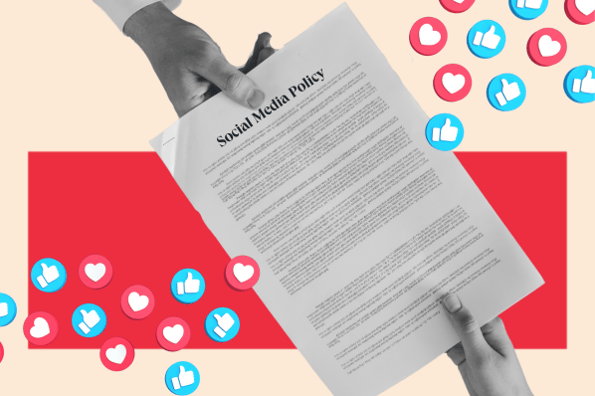8 Noteworthy Examples of Corporate Social Media Policies
Like it or not, social media is ingrained in our everyday lives. People use it to share their happy moments and grievances, ask questions, and even find jobs while employers market themselves and connect with their buyers.

Like it or not, social media is ingrained in our everyday lives. People use it to share their happy moments and grievances, ask questions, and even find jobs while employers market themselves and connect with their buyers. This is all fine and dandy, but what happens if someone posts about work or voices a contrasting personal opinion? This murky middle ground is why having a social media policy is so important for your business. Well-thought-out corporate social media policies help keep a company’s presence consistent and scalable, no matter who posts or where. Yet, 45% of companies still don’t have one in place. I’m here to help fix that. Let’s break down how to create a social media policy that is right for your team and look at some examples done well. Table of Contents A social media policy outlines how your business uses social media channels and what employees should and should not post. It encourages employees to share about the company with their online networks but aims to protect a company’s reputation by establishing guidelines for what’s acceptable. Does more than one person manage your social media accounts? Do you expect your employees to promote your business on their personal profiles? Or would you rather they don’t discuss office culture or their day-to-day period at all? In organizations with a large online presence or well-established public images, a social media policy helps answer these questions and set guardrails for how the company should be represented. Think about it: Every person you hire has their own personality, tone of voice, and views. That may even be the reason you hired them. But the truth is, we live in volatile times. There is much political and societal unrest, and things get complicated when an employee’s views or even behavior after hours contrasts with those of the organization, its values, or its buyers. Corporate social media policies help combat and navigate these situations. They can also help ensure that personal views don’t seep into posts on your brand’s social media accounts either. Now, I know. Some of you may be worried that enforcing strict rules in a social media policy stifles creativity or restricts freedom of speech. But if done correctly, it shouldn’t hinder employees. In fact, it should make them feel more comfortable amplifying your social media messages since they’ll know exactly what will or won’t be beneficial. They don’t have to guess. Good social media policies remove ambiguity. They give teams a single, documented playbook to follow and ultimately help every post about the company align with a brand’s values, tone, and goals. Also, while no one wants their social media policy to be grounds for disciplinary action, it does give businesses somewhat of a safety net should things go awry. I witnessed the importance of this first-hand during a presidential election at a previous employer. We didn’t have a social media policy at the time, and my teammate posted something politically charged on their personal profile. Some third-party partners saw the post and were upset, putting the company in a difficult spot. This likely could have been avoided if a social media policy had been established. To get more granular, here are a few major benefits of creating a corporate social media policy: So, what does a great social media policy look like? First off, remember there isn‘t just one ’right' policy that works for every company. Below, I’ve shared several components that, from my experience, make for great social media policies — but some may not make sense for your team, business, or industry. Pick and choose what you like to fit your culture and business objectives. 8. Engagement Guidelines (for Responding to Public Interaction) Creating a comprehensive social media policy helps empower employees to use social media effectively while minimizing risks to the company’s brand and reputation. Social media policies can take many different shapes and forms. Need some putting yours together? Our free social media policy template will help you collect your thoughts into a formal document that can be downloaded as a Word document, Google doc, or PDF. Let's explore how prominent companies created effective social media policies to inspire your own today. Best Buy has a social media policy in place that preemptively addresses privacy concerns that could arise using social media. What do I like about Best Buy's social media policy? What could be better? Adobe keeps it even shorter than Best Buy, including social media simply as a footnote its much longer “Code of Business.” What do I like about Adobe’s social media policy? What could be better? Walmart is dedicated to its social media accounts and believes in social media as an avenue for customer service. Its social media policy mentions all the networks it has a presence on, zeroes in on Twitter (X), Facebook, and Instagram. What do I like about Walmart’s social media policy? What could be better? Ford focuses solely on its Facebook page in its most current social media policy version. A PDF of “Ford Motor Company’s Digital Participation Guidelines” is also circulating online, but it is over 14 years old and includes several rebranded social media networks. What do I like about Ford’s social media policy? What could be better? Coca-Cola doesn’t have a social media policy in the traditional form, but rather “responsible social media principles” it promises to abide by. This establishes a more timeless “brand” of social media for Coke rather than specific practices that may become dated quickly. What do I like about Coke’s social media policy? What could be better? Swaybase shares a document covering these items, but is unclear if this content is still in use. The New York Times (NYT) recognizes the price of its popularity — namely, that anything its employees state on their personal accounts could come across as the official opinion of The Times. It also recognizes how essential social media is to its position as a credible house of journalism, making that very clear in its social media policy. What do I like about NYT’s social media policy? What could be better? Oracle is pretty tight-lipped about its social media practices. This is made apparent by reports in 2014 that they fired an employee for discussing their plans for X (then Twitter). Oracle's social media participation policy documents how social media is used as a business, but its employee code of conduct and business ethics touch on how employees can engage in personal social media. What do I like about Oracle’s social media policy? What could be better? Every organization should take precautions to make sure their classified information isn’t shared recklessly on social media. But this is even more critical for government agencies like the U.S. Department of Defense. What do I like about Oracle’s social media policy? What could be better? Ultimately, the rules and regulations you choose to include in your policy should reflect your own brand's values, messaging, and tone. However, you can use these examples and guidelines to ensure you include statements that can help protect you against legal or regulatory disputes in the future based on an employee's social media posts. Additionally, aim to use your social media policy as your first step toward increasing the effectiveness of your social media strategies and ensuring a positive brand image on any platform on which you post.
What is a social media policy?
Why is having a social media policy important?
Benefits of a Corporate Social Media Policy
Components of a Social Media Policy
1. Purpose and Scope
Outline the purpose of the policy and its importance in protecting both the company's reputation and employees’ rights.
Encourage responsible, respectful communication and emphasize that employees represent the company even on personal accounts.
Specify who the policy applies to (e.g., all employees, contractors, interns, etc.).
2. Employee Guidelines for Personal Accounts
Specify when and how employees can discuss work-related topics on personal accounts.
Encourage disclaimers like “views are my own” when relevant, especially if discussing industry-related topics.
Provides guidance on sharing public information versus confidential details.
3. Guidelines for Social Media Use During Work Hours
These days, personal smartphones and tablets are not just permitted at the workplace but are even required for some jobs. Therefore, setting guidelines for personal social media use at the office is essential.
This could include time limits, phone-free areas or events, etc.
4. Brand Voice and Tone
Detail the brand's tone, style, and messaging standards for official social media channels.
Clarify how employees should align with the brand’s image if they represent the company.
5. Confidentiality and Privacy Concerns
Emphasize the importance of protecting proprietary company information, customer data, and client details.
Include examples of what constitutes confidential information.
6. Intellectual Property Protection
Outline rules for using company logos, images, and other branding materials on personal accounts.
Specify that company content should not be reproduced without permission.
You also may want to go into rules for user-generated content or republishing content that tags or is shared on your social media platforms by your audience.
7. Official Social Media Responsibilities
Outline which departments or individuals handle official accounts, post frequency, and escalation procedures.
Provide a list of official accounts and expectations. (This may include what audiences can expect from your brand as well as what you expect employees to do when managing your social media accounts.)
9. Security and Privacy Protocols
List steps to protect official accounts, such as using strong passwords, two-factor authentication, and limiting access.
Provides guidance on recognizing and handling potential security threats (e.g., phishing, hacking attempts).
10. Legal and Regulatory Compliance
Highlight legal considerations, such as compliance with advertising standards, disclosure requirements, and industry-specific regulations (e.g., HIPAA for healthcare, GDPR for EU).
11. Consequences of Policy Violations
Clearly state the disciplinary actions for violating the policy, from warnings to termination for serious infractions.
Ensure this section is in line with existing company policies on disciplinary actions.
12. Resources and Training
Provide links to resources for further reading or training on effective social media use.
Offer contact information for team members who can answer questions or provide guidance on specific scenarios.
13. Plan for Updates
Explain how and when the policy will be reviewed and updated to reflect social media or business strategy changes.
Consider scheduling a regular review to keep up with evolving social media trends and regulations.
How to Create a Social Media Policy
8 Examples of Great Social Media Policies
1. Best Buy

2. Adobe

3. Walmart

4. Ford Motors

5. Coca-Cola

6. The New York Times

7. Oracle

8. U.S. Department of Defense Social Media Policy

A great social media policy is step one.

 Konoly
Konoly 














![Your Local Networking is Killing Your Business. – Jena Apgar [VIDEO]](https://www.digitalmarketer.com/wp-content/uploads/2022/03/YOUTUBETHUMB_JenaNetworking_1.jpeg)

















.jpg&h=630&w=1200&q=100&v=154b70b92d&c=1)
